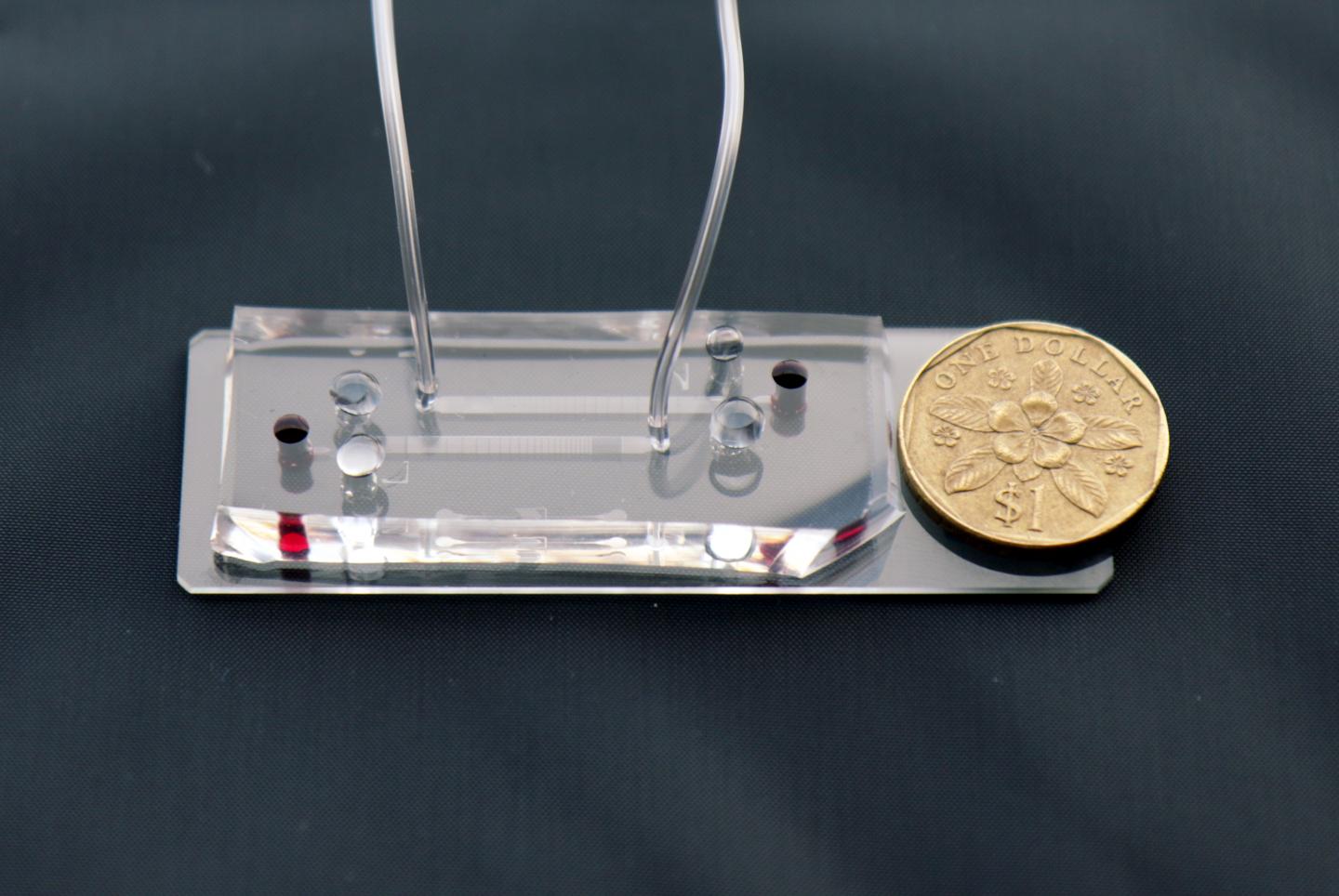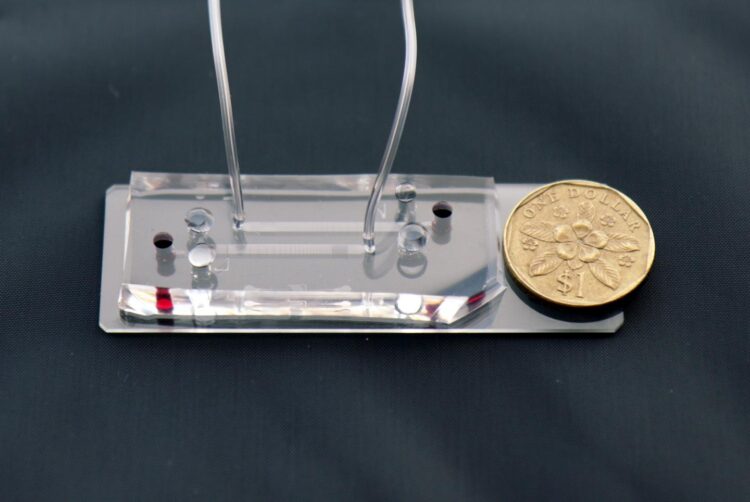Novel DLD assay is capable of rapidly assessing host inflammatory response, allowing patients exhibiting a life-threatening hyper-aggressive immune response to be identified and treated expeditiously

Credit: Singapore-MIT Alliance for Research and Technology (SMART)
- The novel label-free assay uses unconventional L and inverse-L shaped pillars of deterministic lateral displacement (DLD) microfluidic technology to quantify and profile immune states of white blood cells (WBCs) by assessing biophysical properties of size, deformation, distribution, and cell count
- The assay requires only 20 microlitres (μl) of unprocessed blood and takes just 15 minutes – much faster than existing methods which require up to 15 millilitres (ml) of blood and take at least a few hours to produce results
- This new technology measures and profiles the often volatile host immune response, resulting in a more accurate assessment of patient pathophysiology
- Current methods for early diagnosis of infection focus on detecting low-abundance pathogens, and are time-consuming, of low sensitivity, and do not accurately reflect the severity of infection
Singapore, 25 March 2021 – Researchers from Critical Analytics for Manufacturing Personalized-Medicine (CAMP), an Interdisciplinary Research Group (IRG) at the Singapore-MIT Alliance for Research and Technology (SMART), MIT’s research enterprise in Singapore, have developed a new label-free immune profiling assay that profiles the rapidly changing host immune response in case of infection, in a departure from existing methods that focus on detecting the pathogens themselves, which can often be at low levels within a host. This novel technology presents a host of advantages over current methods, being both much faster, more sensitive and accurate.
The new assay is described in a paper titled, “Label-free biophysical markers from whole blood microfluidic immune profiling reveals severe immune response signatures”, published recently in Small, a weekly peer-reviewed scientific journal covering nanotechnology, and included a pilot study of 85 donors recruited from the National University Hospital (NUH) emergency department. The paper was led by Dr Kerwin Kwek Zeming, senior postdoctoral associate at SMART CAMP, and co-authored by Professor Jongyoon Han, Principal Investigator at SMART CAMP and Professor of Biological Engineering and Electrical Engineering at MIT, and Dr Win Sen Kuan, Research Director, Emergency Medicine Department, NUH.
In many cases, the main culprit behind disease manifestation, severity of infection, and patient mortality is an overly aggressive host immune response. For instance, the Spanish Flu pandemic of 1918 resulted in a disproportionately high number of deaths among otherwise healthy young adults. This has been attributed to the now well-studied phenomenon of cytokine storms, which precipitate the rapid release of immune cells and inflammatory molecules and are brought on by a hyper-aggressive host immune response. In a more recent example, cases of severe COVID-19 infection often result in death via sepsis and a dysregulated immune response, while current risk stratification methods based on age and comorbidity remain a significant challenge and can be inaccurate. Moreover, current Covid-19 testing does not prognose the severity of the immune response and can thus lead to inefficient deployment of resources in healthcare settings.
In cases of acute infection, the status of a patient’s immune response can often be volatile and may change within minutes. Hence, there exists a pressing need for assays that are able to rapidly and accurately inform on the state of the immune system. This is particularly vital in early triage among patients with acute infection and prediction of subsequent deterioration of disease. In turn, this will better empower medical personnel to make more accurate initial assessments and deliver the appropriate medical response. This can ensure timely intervention in the emergency department (ED) and prevent admission to the intensive care unit (ICU).
The new assay developed by SMART researchers focuses on profiling the rapidly changing host inflammatory response, which in a hyper-aggressive state, can lead to sepsis and death. A 15-minute label-free immune profiling assay from 20 μL of unprocessed blood using unconventional L and inverse-L shaped pillars of DLD microfluidic technology was developed, functioning as a sensitive and quantitative assay of immune cell biophysical signatures in relation to real-time activation levels of WBCs. As WBCs are activated by various internal or external triggers, the assay can sensitively measure both the extent and direction of these changes, which in turn reflect a patient’s current immune response state. As such, the new assay developed by SMART researchers is able to accurately and quickly assess patients’ immune response states by profiling immune cell size, deformability, distribution, and cell counts.
Significantly, the new assay provides considerable advantages over existing methods of profiling the immune system and its activity. These include measuring leukocyte gene expression, cell-surface biochemical markers, and blood serum cytokine profile. Notably, these current methods require sample dilution or pre-processing steps, as well as labour-intensive, expensive equipment and antibody labelling procedures. As a result, these methods generally require a few hours, at minimum, to return results. This is a key pain point and drawback in triage and the emergency department, where clinicians need to make accurate clinical assessments as early as possible. The labour- and time-intensive nature of these current methods significantly limits their clinical utility for rapid triage and prevents their wider implementation within the ER or ICU.
In contrast, as this new SMART assay takes only 15 minutes, uses only 20 μL of whole blood, and only requires video capture frame rates of up to 150 fps, there is considerable potential for the technology to be developed into a portable unit that can perform point-of-care blood-sparing assays which could significantly improve the diagnosis and differentiation of patients in the ER and other primary or critical care settings. This application will enable clinicians to be able to quickly identify at-risk patients and take immediate action to mitigate or prevent organ dysfunction and other adverse effects of a hyper-aggressive immune response.
Lead author Dr Kerwin Kwek said, “Our new DLD assay will help address an unmet need in the ER and ICU by significantly reducing waiting time for accurate patient assay results. This could lead to more effective triage decision-making and more appropriate and timely treatment, which are critical to saving lives. More generally, this groundbreaking technology provides new insights into both the engineering of precision microfluidics and clinical research.”
Professor Jongyoon Han added, “In the wake of lessons learnt in emergency rooms in hospitals across the world especially during the COVID-19 pandemic, where medical professionals have been faced with making difficult and at times life-or-death decisions in triage, this new technology represents a hugely exciting and significant breakthrough. By reducing the time taken for assay results from hours to a matter of minutes, SMART CAMP’s new assay could help save lives as we continue to combat the scourge of pathogens and infectious diseases. The assay will also have wider applications, giving clinicians a new and more effective tool in the ER and ICU.”
###
The research is carried out by SMART and supported by the National Research Foundation (NRF) Singapore under its Campus for Research Excellence And Technological Enterprise (CREATE) programme.
About Critical Analytics for Manufacturing Personalized-Medicine (CAMP)
CAMP is a SMART interdisciplinary research group launched in June 2019. It focuses on better ways to produce living cells as medicine, or cellular therapies, to provide more patients access to promising and approved therapies. The investigators at CAMP address two key bottlenecks facing the production of a range of potential cell therapies: critical quality attributes (CQA) and process analytic technologies (PAT). Leveraging deep collaborations within Singapore and MIT in the United States, CAMP invents and demonstrates CQA/PAT capabilities from stem to immune cells. Its work addresses ailments ranging from cancer to tissue degeneration, targeting adherent and suspended cells, with and without genetic engineering.
CAMP is the R&D core of a comprehensive national effort on cell therapy manufacturing in Singapore.
For more information, please visit: https:/
About Singapore-MIT Alliance for Research and Technology (SMART)
Singapore-MIT Alliance for Research and Technology (SMART) is MIT’s Research Enterprise in Singapore, established by the Massachusetts Institute of Technology (MIT) in partnership with the National Research Foundation of Singapore (NRF) since 2007. SMART is the first entity in the Campus for Research Excellence and Technological Enterprise (CREATE) developed by NRF. SMART serves as an intellectual and innovation hub for research interactions between MIT and Singapore. Cutting-edge research projects in areas of interest to both Singapore and MIT are undertaken at SMART. SMART currently comprises an Innovation Centre and five Interdisciplinary Research Groups (IRGs): Antimicrobial Resistance (AMR), Critical Analytics for Manufacturing Personalized-Medicine (CAMP), Disruptive & Sustainable Technologies for Agricultural Precision (DiSTAP), Future Urban Mobility (FM) and Low Energy Electronic Systems (LEES).
SMART research is funded by the National Research Foundation Singapore under the CREATE programme.
For more information, please visit: http://smart.
For media queries, please contact:
Glenn Tan
[email protected]
+65 9658 5749
Media Contact
Glenn Tan
[email protected]
Original Source
https:/
Related Journal Article
http://dx.





